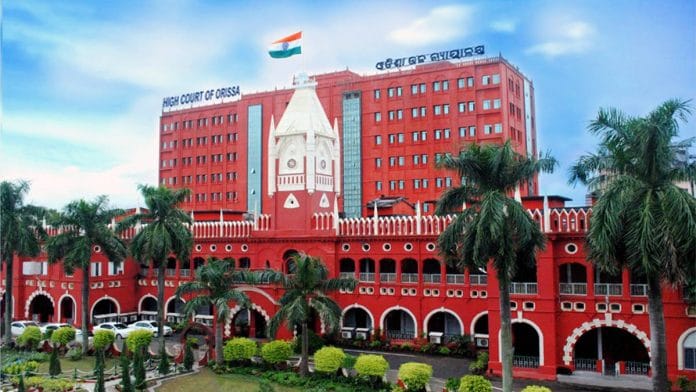New Delhi: The Orissa High Court has become the first in the country to publish an annual report that gives insights into the performance of the state’s judiciary, and the findings are not pretty.
Docket explosion, an uneven distribution of cases among district judges, unavailability of witnesses, suspects facing trial going missing, and non-implementation of a 2018 Supreme Court judgment that doesn’t allow a stay to operate for more than six months, the report says, have led to a high number of cases pending in Odisha’s district courts.
The report, for the year 2021, was released online last week. It also details the expenditure the judiciary incurred in 2021, as well as initiatives taken at the administrative level to reduce the number of cases pending in district courts, and measures taken to use technology to improve the administration of justice.
A chapter in the report — ‘Introspection and Challenges’ — analyses the factors due to which the performance of the judiciary “appears to have fallen short of expectations”. While a low judge: population ratio in the state is cited as the main reason for the large pendency of cases, the report also discusses other factors at length.
Also read: India’s higher judiciary lacks professional diversity. It’s now a monopoly of lawyer-judges
Tackling pendency
“Undoubtedly, the greatest challenge to the judiciary is docket explosion i.e. increase in the pendency of cases. While the increase in the institution of cases reflects people’s faith in the judiciary, it also poses challenges,” the report says.
According to the report, at the beginning of 2021, a total of 1,73,510 cases were pending in the Orissa High Court. But over the course of the year, 1,28,943 fresh cases were instituted, while 1,05,334 were decided. Therefore, pendency at the end of the year rose to 1,97,119.
With the abolition of the Odisha Administrative Tribunal — a quasi-judicial body that heard disputes between government employees and employers — around 40,000 cases were transferred to the HC, burdening it further, the report says.
In the trial courts, the number of pending cases at the end of 2021 rose from 15,92,250 to 17,89,677.
In district courts, a breakdown of cases shows that at the beginning of 2021, as many as 12,236 cases going back 25 years were awaiting final disposal, but in the course of the year, 2,907 new cases were added.
With concerted efforts, the number of pending cases in this category was brought down to 9,540, the report says.
A similar approach helped trial courts dispose of 40-year-old cases. While there were 305 such matters pending at the start of 2021, only 164 are now pending.
A major cause of pendency in district courts is the operation of stay orders by higher courts, according to the report.
It asserts that courts haven’t been implementing a 2018 judgment of the Supreme Court, which ruled that a stay order wouldn’t operate for more than six months, unless an extension is granted in a specific ‘speaking order’ (an order that spells out its reasons).
The SC judgment gave trial courts the liberty to resume proceedings (after six months) without waiting for any other intimation.
Quoting this judgment, Chief Justice of the Orissa HC S. Muralidhar sent out two letters to all state judicial officers in April and October 2021, asking them to follow the law.
As a result, 131 of 154 cases going back 40 years, and 703 of 1,237 matters going back 25 years, which had been unable to proceed due to stays, were decided, says the report.
Other factors behind case pile-up
Analysing court data, the report finds the uneven distribution of cases among district judges to be a cause for concern. It identifies six Odisha districts as “heavy pendency districts”. One such district is Khordha, which has 1,91,122 pending cases, of which the the greatest number — 82,960 — have piled up in just one court, that of the sub-divisional judicial magistrate of Bhubaneswar.
Other reasons cited for the slow disposal of cases include suspects facing trial going missing, non-availability of witnesses, non-apprehension of accused — particularly in cases of petty crimes — and inability to find surety for bail.
It’s also due to these reasons that special courts set up to hear cases under the Protection of Children from Sexual Offences (POCSO) Act, crimes against women, vigilance cases and those filed under the SC/ST Act have not met expectations, says the report.
In civil cases, especially property-related matters, summons not being served on parties is the primary reason behind delays in trials. The non-availability of amin commissioners —who demarcate land, identify properties and allot land following court decrees — has also led to a large number of preliminary decrees pending in courts.
Cases are also pending on account of deceased parties not being substituted with their legal heirs in suits, or this being done belatedly, the report says.
The judge-population ratio — the number of judges per million population — is low in Odisha at 20.52, compared to the national average of 21.03.
According to the report, the sanctioned strength of judges on the high court is 33, but the present working strength is only 21. The report contends that the appointment of judges to the HC involves a lengthy process and hence, four of the five candidates recommended in March 2021 were appointed only in November that year. The last appointments made to the Orissa HC were in February this year.
As for the district judiciary, the report says that 785 judges are currently working in trial courts in the state.
(Edited by Nida Fatima Siddiqui)
Also read: How SC wants to streamline tribunal appointments even if govt objects to court’s choice






